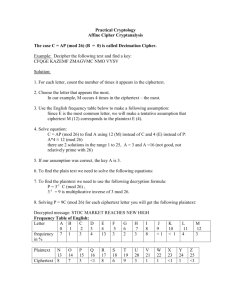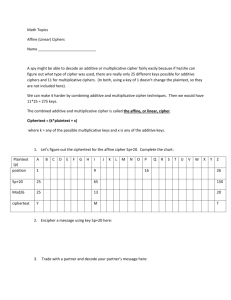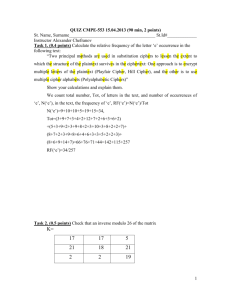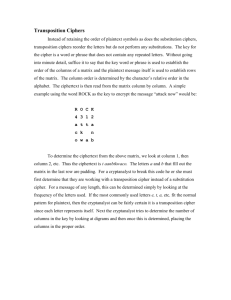IMPLEMENTING AN AFFINE CIPHER SYSTEM
advertisement
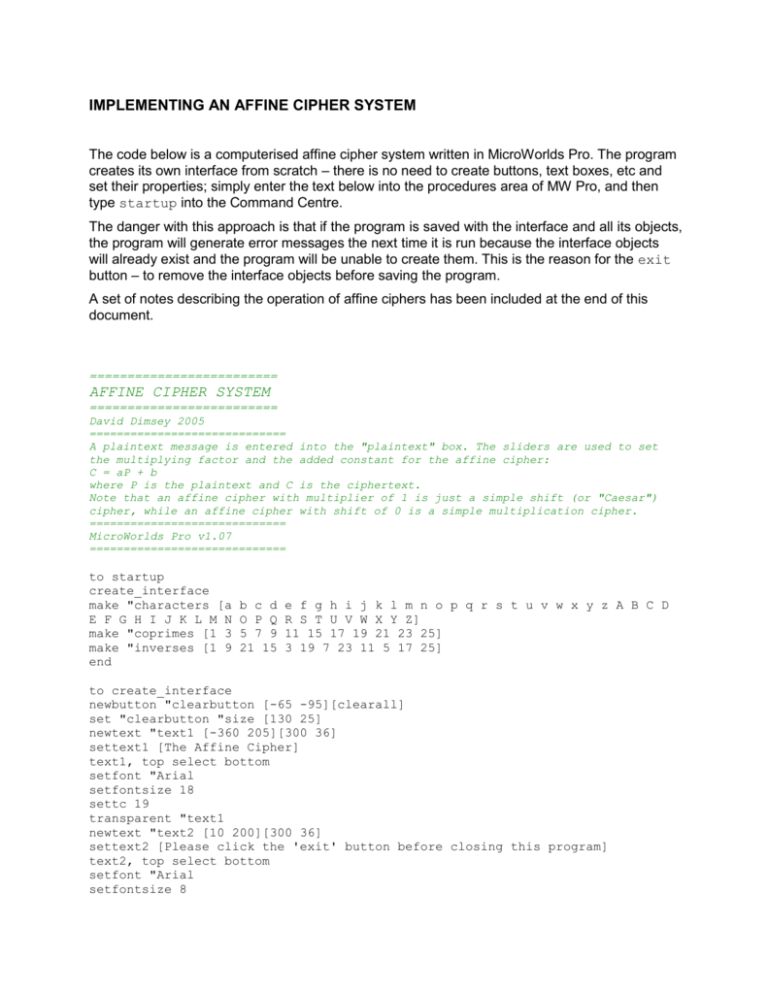
IMPLEMENTING AN AFFINE CIPHER SYSTEM
The code below is a computerised affine cipher system written in MicroWorlds Pro. The program
creates its own interface from scratch – there is no need to create buttons, text boxes, etc and
set their properties; simply enter the text below into the procedures area of MW Pro, and then
type startup into the Command Centre.
The danger with this approach is that if the program is saved with the interface and all its objects,
the program will generate error messages the next time it is run because the interface objects
will already exist and the program will be unable to create them. This is the reason for the exit
button – to remove the interface objects before saving the program.
A set of notes describing the operation of affine ciphers has been included at the end of this
document.
=========================
AFFINE CIPHER SYSTEM
=========================
David Dimsey 2005
=============================
A plaintext message is entered into the "plaintext" box. The sliders are used to set
the multiplying factor and the added constant for the affine cipher:
C = aP + b
where P is the plaintext and C is the ciphertext.
Note that an affine cipher with multiplier of 1 is just a simple shift (or "Caesar")
cipher, while an affine cipher with shift of 0 is a simple multiplication cipher.
=============================
MicroWorlds Pro v1.07
=============================
to startup
create_interface
make "characters [a
E F G H I J K L M N
make "coprimes [1 3
make "inverses [1 9
end
b c d
O P Q
5 7 9
21 15
e f g h i j k l m n o p q r s t u v w x y z A B C D
R S T U V W X Y Z]
11 15 17 19 21 23 25]
3 19 7 23 11 5 17 25]
to create_interface
newbutton "clearbutton [-65 -95][clearall]
set "clearbutton "size [130 25]
newtext "text1 [-360 205][300 36]
settext1 [The Affine Cipher]
text1, top select bottom
setfont "Arial
setfontsize 18
settc 19
transparent "text1
newtext "text2 [10 200][300 36]
settext2 [Please click the 'exit' button before closing this program]
text2, top select bottom
setfont "Arial
setfontsize 8
settc 19
transparent "text2
newbutton "exitbutton [305 197][exit]
set "exitbutton "size [50 20]
newtext "plaintext [-360 160][350 250]
newtext "ciphertext [10 160][350 250]
newbutton "clearplainbutton [-280 -120][clear plainbox]
set "clearplainbutton "size [130 25]
newbutton "clearcipherbutton [150 -120][clear cipherbox]
set "clearcipherbutton "size [130 25]
newbutton "encryptbutton [-280 -150][encrypt plaintext]
set "encryptbutton "size [130 40]
newbutton "decryptbutton [150 -150][decrypt ciphertext]
set "decryptbutton "size [130 40]
newslider "shift [-125 -150][0 25 0]
newslider "multiplier [10 -150][1 26 1]
setbg 40
end
to exit
remove "clearbutton
remove "text1
remove "plaintext
remove "ciphertext
remove "clearcipherbutton
remove "clearplainbutton
remove "encryptbutton
remove "decryptbutton
remove "text2
remove "shift
remove "multiplier
remove "exitbutton
end
to encrypt :plaintext
if not member? multiplier :coprimes [announce [Not a valid multiplier]
setmultiplier 1 stop]
make "ptext caps checktext :plaintext
make "ctext "
encrypt1 :ptext
setciphertext fives :ctext
ciphertext, top select bottom
setfont "|Courier New| setstyle "regular
top
end
to encrypt1 :ptext
if empty? :ptext [stop]
make "ctext word :ctext char sum mod sum product difference ascii first :ptext
65 multiplier shift 26 65
encrypt1 bf :ptext
end
to decrypt :ciphertext
make "ctext lower checktext :ciphertext
make "ptext "
findpos multiplier :coprimes
make "mult item :spot :inverses
decrypt1 :ctext
setplaintext :ptext
plaintext, top select bottom
setfont "|Courier New| setstyle "regular
top
end
to decrypt1 :ctext
if empty? :ctext [stop]
make "current difference ascii first :ctext 97
make "ptext word :ptext char sum mod product difference :current shift :mult
26 97
decrypt1 bf :ctext
end
to clear :boxname
if equal? :boxname "cipherbox [setciphertext "]
if equal? :boxname "plainbox [setplaintext "]
end
to findpos :num :list
if empty? :list [stop]
make "spot 1
findpos1 :num :list
end
to findpos1 :num :list
if equal? :num first :list [stop]
make "spot sum :spot 1
findpos1 :num bf :list
end
to cipherbox
op "cipherbox
end
to plainbox
op "plainbox
end
to clearall
setplaintext "
setciphertext "
end
to checktext :intext
if empty? :intext [op " ]
if member? first :intext :characters
[op word first :intext checktext bf :intext ]
checktext bf :intext
end
to lower :inword
if equal? :inword " [op " ]
ifelse (ascii first :inword) > 96
[op word first :inword lower bf :inword]
[op word char ((ascii first :inword) + 32) lower bf :inword]
end
to caps :inword
if equal? :inword " [op " ]
ifelse (ascii first :inword) > 96
[op word char ((ascii first :inword) - 32) caps bf :inword]
[op word first :inword caps bf :inword]
end
to fives :inword
if (count :inword) < 5 [op :inword]
op se word first :inword word first bf :inword word first bf bf :inword word
first bf bf bf :inword first bf bf bf bf :inword
fives bf bf bf bf bf :inword
end
to mod :a :b
if :a > 0 [op remainder :a :b]
op mod sum :a :b :b
end
The program creates this interface:
SOME NOTES ABOUT AFFINE CIPHERS
1.
Additive (or Shift) ciphers
The well-known “Caesar” cipher is one example of the class of ciphers known as shift ciphers. In
these cipher systems, the algorithm is to represent each letter in the plaintext by the letter that is
k places further on in the alphabet (hence k is the key for the cipher). The classic Caesar cipher
has a shift of 3.
To make the process of encryption and decryption easier and more amenable to computer
processing, it is best to represent the letters of the alphabet as numbers from 0 to 25, with A 0,
B 1, C 2, and so on.
The generalised shift cipher is one in which the letters of the plaintext can be shifted by adding
any number to obtain the cipher text; well, not just any number: a shift of 0 will produce a
ciphertext that is identical with the plaintext, with no concealment at all of the message. Similarly,
a shift of 26 will also produce a ciphertext that is identical with the plaintext.
Also, a shift of 27 will be identical with a shift of 1; a shift of 28 identical with a shift of 2, and so
on. We therefore need only to consider ciphers with shifts between 1 and 25.
This is actually modular arithmetic, with the modulus being 26. The letters of the alphabet are
associated with the integers modulo 26. These integers are just the possible remainders when
an integer is divided by 26.
Our shift cipher is then defined by the rule:
C = P + k (mod 26)
Where P is a letter of the plaintext, expressed as a number from 0 to 25, k is the key, and is a
whole number in the range 1 to 25, and C is the corresponding ciphertext letter, expressed as a
whole number from 0 to 25.
A coding scheme for representing letters as numbers does exist for use in computers, and for
other forms of communication. The scheme is the American Standard Code for Information
Interchange, or the ASCII code. In this code, A = 65, B = 66, through to Z = 90, and a = 97, b =
98 through to z = 122.
To implement a shift cipher, the process is:
For each letter of the plaintext
Convert the letter in upper case (if it is not already)
Express this letter as its ASCII code
Subtract 65 from the ASCII code
Add the key value k
Express the result modulo 26
Add 65
Convert this ASCII code to its corresponding letter
Repeat until all the letters of the plaintext have been encrypted
Notice that for a shift cipher, a letter cannot be encrypted as itself.
ASCII code is used in all computer applications, and an application such as a spreadsheet can
be used to construct a very primitive computerised encryption tool that implements this process:
The formula used in cell A4 is:
=IF(A1=” “,” “,CHAR((MOD((CODE(UPPER(A1))-65)+7,26))+65))
The plaintext is entered in row 1 of the spreadsheet, one letter per cell, and the cipher text
appears in row 4 of the spreadsheet.
Decryption simply reverses the process:
The formula in cell A7 is:
=IF(A4=” “,” “,CHAR(MOD((CODE(A4)-65)-7,26)+97))
2.
Multiplicative ciphers
If we can create a cipher based on adding some number (mod 26) to our plaintext, then we can
surely create one that multiplies the numerical plaintext values to obtain the ciphertext.
For instance, if we multiplied the plaintext values by, say, 3, we have:
t
o
b
e
o
r
n
o
t
t
o
b
e
19
14
1
4
14
17
13
14
19
19
14
1
4
ciphertext
number
5
16
3
12
16
25
13
16
5
5
16
3
12
ciphertext
F
Q
D
M
Q
Z
N
Q
F
F
Q
D
M
plaintext
plaintext number
Notice that “A” (with a numerical value of 0) will always be encrypted as itself in this system.
There is a problem with the multiplicative cipher if we use 4 as the multiplier:
t
o
b
e
o
r
n
o
t
t
o
b
e
plaintext number
19
14
1
4
14
17
13
14
19
19
14
1
4
ciphertext number
24
4
4
16
4
16
0
4
24
24
4
4
16
Y
E
E
Q
E
Q
A
E
Y
Y
E
E
Q
plaintext
ciphertext
OOPS! Both “o” and “b” from the plaintext have been encrypted as “E”, while both “e” and “r”
have been encrypted as “Q”. The recipient of the message will not be able to decipher it,
because she will not know whether to decipher the ciphertext “Q” as “e” or “r”, nor whether to
decipher the letter “E” as “o” or “b”. A cryptosystem in which encrypted messages cannot be
accurately decrypted is not very useful.
It seems that we cannot multiply by just any number. We need a multiplier for which all of its
multiples mod 26 must be different. This occurs if the multiplier k is relatively prime to the
modulus 26. That is, the greatest common divisor of 26 and k is 1.
It is easy to verify that the allowable set of multipliers is {1, 3, 5, 7, 9, 11, 15, 17, 19, 21, 23 25}
Decryption of a multiplicative cipher presents some difficulty. Reversing the multiplication
process is not just a matter of dividing the ciphertext number by the mutiplier to obtain the
plaintext number. In our first example above, the multiplier was 3. However, not all of the
ciphertext numbers are multiples of 3. Hnece, if we just divide all of the ciphertext numbers by
3,we get some non-integer results, which cannot be converted to letters at all. How then do we
decrypt a multiplicative cipher?
With a modular arithmetic such as we have been using, we need to identify that the inverse
operation to multiplication is not division, but the operation of multiplying by the multiplicative
inverse of the number involved. The multiplicative inverse of a number modulo 26 is the number
that must be multiplied by the first number to give a value of 1 (which is called the identity for
multiplication).
To find the multiplicative inverses for the set of allowable multipliers, we need to perform all of
the possible multiplications, and find those that give a result of 1.
It is a relatively easy task to set up a spreadsheet to perform this calculation for us:
1
3
5
7
9
11
15
17
19
21
23
25
1
1
3
5
7
9
11
15
17
19
21
23
25
3
3
9
15
21
1
7
19
25
5
11
17
23
5
5
15
25
9
19
3
23
7
17
1
11
21
7
7
21
9
23
11
25
1
15
3
17
5
19
9
9
1
19
11
3
21
5
23
15
7
25
17
11
11
7
3
25
21
17
9
5
1
23
19
15
15
15
19
23
1
5
9
17
21
25
3
7
11
17
17
25
7
15
23
5
21
3
11
19
1
9
19
19
5
17
3
15
1
25
11
23
9
21
7
21
21
11
1
17
7
23
3
19
9
25
15
5
23
23
17
11
5
25
19
7
1
21
15
9
3
25
25
23
21
19
17
15
11
9
7
5
3
1
So, for the set of allowable multipliers {1, 3, 5, 7, 9, 11, 15, 17, 19, 21, 23 25}, the corresponding
inverses are {1, 9, 21, 15, 3, 19, 7, 23, 11, 5, 17, 25}
In our first example, the multiplier was 3. To decrypt the message, we multiply each of the
ciphertext numbers by 9, the multiplicative inverse of 3:
ciphertext
F
V
M
J
Y
M
Y
C
G
A
C
F
ciphertext number
5
21
12
9
24
12
24
2
6
0
2
5
19
7
4
3
8
4
8
18
2
0
18
19
t
h
e
d
i
e
i
s
c
a
s
T
plaintext number
plaintext
5 x 9 = 45 = 26 x 1 + 19 = 19 (mod 26)
3.
Affine ciphers
An affine cipher combines both the additive and multiplicative ciphers by using two keys, say a
and b. A plaintext letter is represented in numerical form, and then this number P is encrypted as
C according to the equation:
C = (aP + b) mod 26
The multiplier a must be relatively prime to 26, and the additive key b is one of the integers in the
range 0 – 25.
Decryption of an affine cipher reverses this process:
P = a-1(C - b) mod 26
Where a-1 is the multiplicative inverse of the multiplier a.
For example, in an affine cipher system with a = 11 and b = 8:
Plaintext: imagination
is more important than knowledge
“i” has the numerical equivalent 8, (8 x 11 + 8) mod 26 = 96 (mod 26) = 18 = “S”
“m” has the numerical equivalent 12, (12 x 11 + 8) mod 26 = 140 (mod 26) = 10 = “K”
“a” has the numerical equivalent 0, (0 x 11 + 8) mod 26 = 8 (mod 26) = 8 = “I”
……… and so on …
to give:
Ciphertext:
SKIWS VIJSG VSYKG NASKR GNJIV JJHIV OVGQZ APWA
Cryptanalysis of an affine cipher can be carried out algebraically. If we know that the ciphertext
results from an affine cipher, then we know that the encryption equation is of the form
C = (aP + b) mod 26
And we know that the decryption equation is therefore of the form
P = a-1(C - b) mod 26
There is a limited number of possible values for a and b, and therefore a limited number of
combinations of a and b that could have been used for the encryption. There are 12 possible
values for the multiplier a (the twelve numbers less than 26 that are also relatively prime to 26 –
see the list above), and 26 possible values for b, for a total of 12 x 26 = 312 possible
combinations of a and b. However, the combination a = 1 b = 0 does nothing, so there are 312 –
1 = 311 nontrivial affine ciphers.
One approach to cracking the cipher, therefore, is to try each pair of values for a and b,
substitute in the ciphertext, and see if an intelligible plaintext emerges.

